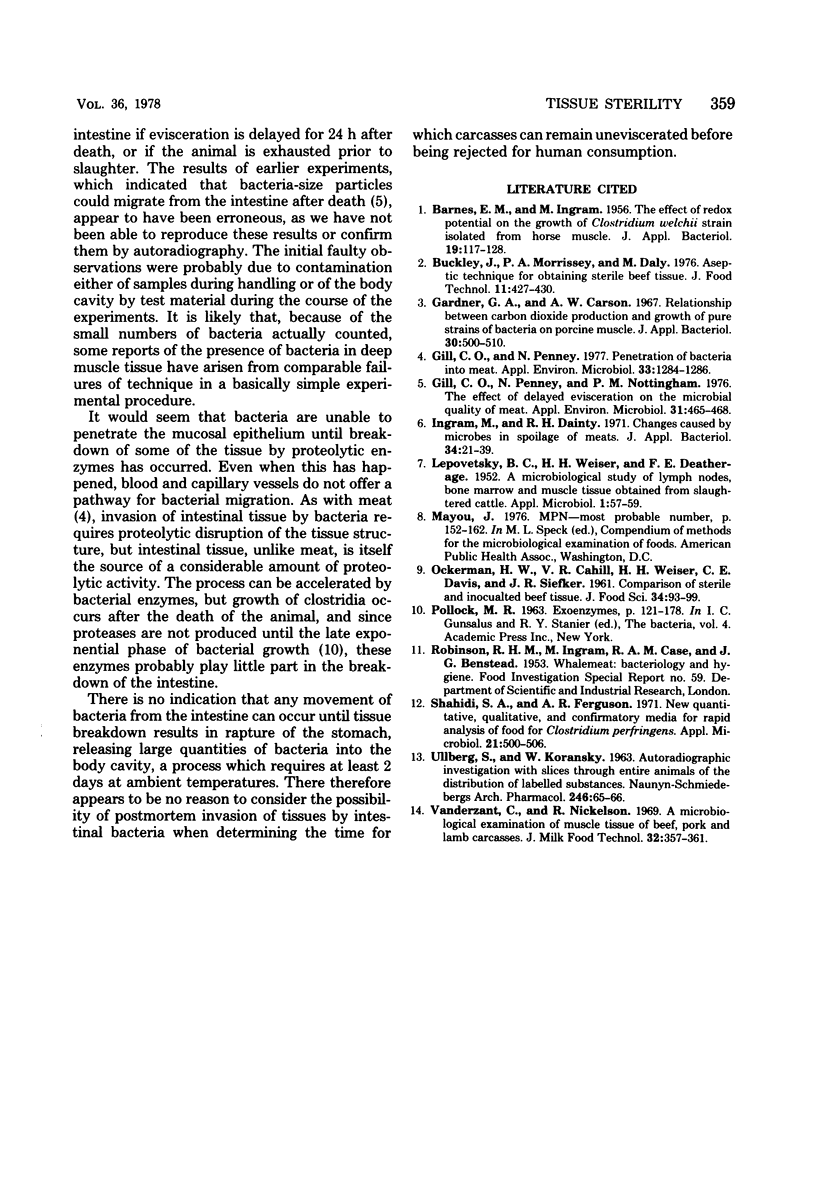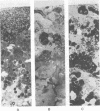Abstract
Sheep muscle tissue removed aseptically from control carcasses, from uneviscerated carcasses held at 20 degrees C for 24 h, and from carcasses of sheep subjected to stress before slaughter was examined for the presence of bacteria. All samples from a total of 68 carcasses were sterile. Whole-body autoradiography of mouse carcasses showed that 14C-labeled fixed bacteria injected after death remained in the lumen of the intestine. Live bacteria did not penetrate the mucosal surface until the tissue structure had been disrupted by proteolytic enzymes. Bacteria were unable to penetrate sections of intestine longitudinally until considerable structural breakdown had occurred, indicating that blood and lymph vessels do not normally offer a pathway for microbial invasion from the intestine. Clostridia, which have been reported to be responsible for deep spoilage of meat, reached maximum numbers 24 to 28 h after death in the intestines of guinea pig carcasses stored at 20 degrees C, but did not invade carcass tissues until the stomach ruptured as a result of proteolysis between 2 and 3 days after death.
Full text
PDF



Images in this article
Selected References
These references are in PubMed. This may not be the complete list of references from this article.
- Gardner G. A., Carson A. W. Relationship between carbon dioxide production and growth of pure strains of bacteria on porcine muscle. J Appl Bacteriol. 1967 Dec;30(3):500–510. doi: 10.1111/j.1365-2672.1967.tb00329.x. [DOI] [PubMed] [Google Scholar]
- Gill C. O., Penney N., Nottingham P. M. Effect of delayed evisceration on the microbial quality of meat. Appl Environ Microbiol. 1976 Apr;31(4):465–468. doi: 10.1128/aem.31.4.465-468.1976. [DOI] [PMC free article] [PubMed] [Google Scholar]
- Gill C. O., Penney N. Penetration of bacteria into meat. Appl Environ Microbiol. 1977 Jun;33(6):1284–1286. doi: 10.1128/aem.33.6.1284-1286.1977. [DOI] [PMC free article] [PubMed] [Google Scholar]
- Ingram M., Dainty R. H. Symposium on microbial changes in foods. Changes caused by microbes in spoilage of meats. J Appl Bacteriol. 1971 Mar;34(1):21–39. doi: 10.1111/j.1365-2672.1971.tb02266.x. [DOI] [PubMed] [Google Scholar]
- LEPOVETSKY B. C., WEISER H. H., DEATHERAGE F. E. A microbiological study of lymph nodes, bone marrow and muscle tissue obtained from slaughtered cattle. Appl Microbiol. 1953 Jan;1(1):57–59. doi: 10.1128/am.1.1.57-59.1953. [DOI] [PMC free article] [PubMed] [Google Scholar]
- Shahidi S. A., Ferguson A. R. New quantitative, qualitative, and confirmatory media for rapid analysis of food for Clostridium perfringens. Appl Microbiol. 1971 Mar;21(3):500–506. doi: 10.1128/am.21.3.500-506.1971. [DOI] [PMC free article] [PubMed] [Google Scholar]



